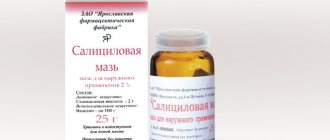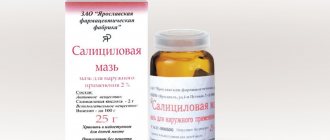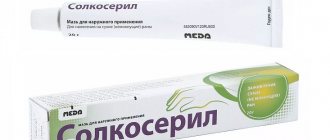What is Solcoseryl ointment used for?
The drug is based on deproteinized dialysate obtained through special processing from the blood of calves. This substance is often used in medicine in countries such as China, Korea, and the entire CIS. It has proven itself to be an effective remedy that can:
- enrich tissue cells damaged due to hypoxia with oxygen and glucose;
- start tissue repair processes;
- activate healthy cell division processes;
- increases the level of energy produced by cells;
- protects the skin from external damage by forming a film on its surface;
- triggers the production of collagen by tissues.
Based on the activity of the drug, the drug can be used for:
- frostbite;
- psoriasis;
- anal ring cracks;
- cuts;
- abrasions;
- scratches;
- bedsores;
- acne marks;
- dermatitis;
First of all, to achieve the best effect, it is necessary to start therapy in the early stages of the problem.
Solcoseryl anti-wrinkle ointment: reviews
Sometimes patients use Solcoseryl facial ointment for cosmetic purposes to get rid of wrinkles.
The logic here is clear - since the drug increases the proliferation and activity of fibroblasts and leads to an increase in collagen production in damaged skin tissues (in wounds), then its regular use should probably lead to an increase in collagen production in healthy, undamaged skin. However, when using Solcoseryl ointment for wrinkles, reviews from cosmetologists indicate the absence of an anti-aging effect. The fact is that the drug affects the production of collagen and the proliferation of fibroblasts exclusively where the skin tissue has been damaged. As soon as the process of tissue restoration ends (and the young granulation tissue that has arisen at the site of damage turns into mature connective tissue), the effect of the drug stops.
However, long-term use of Solcoseryl ointment for the face (given the content of a fatty substance in it) can moisturize the skin, making it a little more elastic. But this does not occur due to an increase in collagen content, but due to a fatty film on the surface of the skin, which prevents the evaporation of moisture and therefore makes the skin a little more hydrated. At the same time, in patients with acne, the ointment can also cause an exacerbation of acne and pimples (due to the Vaseline content).
To stimulate collagen production in aging skin, the following 2 types of products are most effective (for arguments and clinical studies, see the links below) –
- products with retinoids,
- fractional lasers.
Solcoseryl ointment as a face mask
Cosmetologists claim that the use of Solcoseryl in the early stages of age-related changes allows you to maintain youthful skin. Timely start of use can replace expensive laser rejuvenation in the salon. First of all, Solcoseryl allows you to get rid of wrinkles and prevent their earlier appearance. The ointment is capable of:
- provide adequate nutrition to the facial skin;
- get rid of acne;
- relieve inflammation;
- improve complexion;
- tighten the oval;
- get rid of wrinkles.
The expected effects are possible due to the fact that using a mask allows you to saturate tissues and cells with oxygen and accelerate regeneration. Thanks to the application of the cream, collagen, which is responsible for skin elasticity, begins to be actively produced. The more collagen produced, the fewer wrinkles your skin will have. It is like a support for a heavy skin sheet, preventing its individual areas from falling through, preventing the formation of wrinkles.
Solcoseryl ointment for external use 20g
Active substance
international nonproprietary name not assigned (non appropriated)
ATX code
D11AX (Other preparations for the treatment of skin diseases)
Dosage forms
for outdoor use
Release form, packaging and composition of the drug
◊ Gel for external use
homogeneous, almost colorless, transparent, dense consistency, with a characteristic light smell of meat broth.
| 1 g | |
| deproteinized dialysate from the blood of healthy dairy calves (in terms of dry matter) | 4.15 mg |
[PRING] methyl parahydroxybenzoate, propyl parahydroxybenzoate, sodium carmellose, propylene glycol, calcium lactate pentahydrate, water d/i.
20 g - aluminum tubes (1) - cardboard packs.
◊ Ointment for external use
in the form of a homogeneous, fatty mass from white to white with a yellowish tint, with a characteristic light odor of meat broth and petroleum jelly.
| 1 g | |
| deproteinized dialysate from the blood of healthy dairy calves (in terms of dry matter) | 2.07 mg |
[PRING] methyl parahydroxybenzoate, propyl parahydroxybenzoate, cetyl alcohol, cholesterol, white petrolatum, water d/i.
20 g - aluminum tubes (1) - cardboard packs.
Clinical and pharmacological group
A drug that improves trophism and tissue regeneration, for external use
Pharmacotherapeutic group
Tissue regeneration stimulator
Indications for use
Solcoseryl gel/ointment is used in the following cases:
- minor damage (abrasions, scratches, cuts);
- 1st and 2nd degree burns (sunburn, thermal burns);
- frostbite - difficult-to-heal wounds (including trophic ulcers and bedsores).
For the treatment of trophic lesions of tissues of various origins, Solcoseryl is used only after removal of necrotic tissue from the wound.
Solcoseryl gel is used in the initial stage of treatment and is applied to fresh wounds, wounds with wet discharge or ulcers with weeping phenomena.
Solcoseryl ointment is used primarily for the treatment of dry (non-wetting) wounds.
Dosage
Solcoseryl is used topically, applied directly to the wound surface after preliminary cleansing of the wound using a disinfectant solution.
Before starting treatment of trophic ulcers, as well as in cases of purulent infection of the wound, preliminary surgical treatment is necessary.
Solcoseryl gel is applied to fresh wounds, wounds with wet discharge, and ulcers with signs of weeping in a thin layer on a cleaned wound 2-3 times a day. It is recommended to lubricate areas where epithelization has begun with Solcoseryl ointment. The use of Solcoseryl gel is continued until pronounced granulation tissue forms on the damaged skin surface and the wound dries out.
Solcoseryl ointment is applied in a thin layer to a cleaned wound 1-2 times a day. Solcoseryl ointment can be used under bandages. The course of treatment with Solcoseryl ointment continues until the wound is completely healed, its epithelization and the formation of elastic scar tissue.
For the treatment of severe trophic damage to the skin and soft tissues, the simultaneous use of parenteral forms of Solcoseryl is recommended.
Contraindications
- hypersensitivity to one of the components of the drug.
Carefully _
should be used if you are predisposed to allergic reactions.
Overdose
There is no information on the effects of an overdose of Solcoseryl gel/ointment.
Side effects
In rare cases, allergic reactions in the form of urticaria and marginal dermatitis may develop at the site of application of Solcoseryl. In this case, you must stop using the drug and consult a doctor.
A short-term burning sensation may be observed at the site of application of Solcoseryl gel. If the burning sensation does not go away for a long time, the use of Solcoseryl gel should be abandoned.
Overdose
The interaction of Solcoseryl with other topical medications has not been established.
Storage conditions
At a temperature not exceeding 30° C. Keep out of the reach of children. Shelf life: 5 years from the date of production. Do not use after the expiration date stated on the package.
Conditions for dispensing from pharmacies
Over the counter.
Special Instructions
Solcoseryl should not be applied to a contaminated wound, since it does not contain antimicrobial components.
If you experience pain, redness of the skin near the site where Solcoseryl was applied, secretion from the wound, or increased temperature, you should immediately consult a doctor.
If, when using Solcoseryl, healing of the affected area is not observed within 2-3 weeks, you should consult a doctor.
Solcoseryl injections: what for
Any surgical intervention is accompanied by a violation of the integrity of the skin and tissues. If the operation involves the removal of some fragment of an internal organ, the body will require a long rehabilitation period, during which the body will be fully or partially restored. Solcoseryl in ampoules can be instantly delivered to tissues, shortening the recovery period. Injections allow you to mobilize all the internal forces of the body to heal wounds, cuts and sutures not only on the outside, but on the internal organs that remain after operations.
Special cases include the prescription of intravenous or intramuscular administration to patients after ophthalmological operations. Solcoseryl ensures active blood circulation, which accelerates the process of adaptation of the organ of vision in the postoperative period, and also reduces the risk of complications.
Solcoseryl (gel), 1 pc., 20 g, gel for external use
Solcoseryl injection solution:
IV
or
IM
.
In the treatment of occlusive diseases of peripheral arteries in stages III–IV according to Fontaine
- IV 20 ml daily. Intravenous drip administration in isotonic sodium chloride solution or 5% glucose solution is possible. The duration of therapy is up to 4 weeks and is determined by the clinical picture of the disease.
In the treatment of chronic venous insufficiency accompanied by trophic disorders (Ulcera cruris)
- IV 10 ml 3 times a week. The duration of therapy is no more than 4 weeks and is determined by the clinical picture of the disease. An important additional measure aimed at preventing peripheral “venous” edema is the application of a pressure bandage using an elastic bandage.
In the presence of local trophic tissue disorders, simultaneous therapy with Solcoseryl jelly and then Solcoseryl ointment is recommended.
In the treatment of ischemic and hemorrhagic strokes in severe and extremely severe forms
as the main course - 10 or 20 ml intravenously, respectively, daily for 10 days. Upon completion of the main course - 2 ml intramuscularly or intravenously for 30 days.
Traumatic brain injury (severe brain contusion)
- IV 1000 mg, daily for 5 days.
If intravenous administration of the drug is not possible, the drug can be administered intramuscularly, usually 2 ml per day undiluted.
When using the undiluted drug intravenously, it must be administered slowly, since it is a hypertonic solution.
Solcoseryl gel, ointment:
topically.
Apply directly to the wound surface after preliminary cleansing of the wound using a disinfectant solution.
Before starting treatment of trophic ulcers, as well as in cases of purulent infection of the wound, preliminary surgical treatment is necessary.
Solcoseryl gel is applied to fresh wounds, wounds with wet discharge, and to ulcers with signs of weeping - a thin layer on a cleaned wound 2-3 times a day. It is recommended to lubricate areas where epithelization has begun with Solcoseryl ointment. The use of Solcoseryl gel continues until pronounced granulation tissue forms on the damaged skin surface and the wound dries out.
Solcoseryl ointment is used primarily for the treatment of dry (non-wetting) wounds.
Solcoseryl ointment is applied in a thin layer to a cleaned wound 1-2 times a day; it can be used under bandages. The course of treatment with Solcoseryl ointment continues until the wound is completely healed, its epithelization and the formation of elastic scar tissue.
For the treatment of severe trophic damage to the skin and soft tissues, the simultaneous use of parenteral forms of Solcoseryl is recommended.
How to inject Solcoseryl for gastritis
Gastritis is a disease of the gastric mucosa that can occur for various reasons. Solcoseryl ampoules will not become the main drug used in the treatment of gastritis, but it can speed up the healing process, while the prescribed therapy will relieve the patient of the source of the problem.
The gastric mucosa can become inflamed not only as a result of poor nutrition, but also as a result of infection with gastrointestinal infections. The attending physician will first conduct an examination and evaluate the test results, which will allow him to prescribe effective therapy. Solcoseryl will be used as an addition to the main treatment, as it will help the stomach tissues to regenerate faster, ulcers to heal, and inflammation to disappear.
Which is better: Metrogyl Denta or Solcoseryl
Both drugs can be used in the treatment of stomatitis. However, it is better to consider them not as drugs of choice, but from the point of view of a combination of two types of gels. The thing is that stomatitis is most often caused by bacterial infection of the tissues of the oral cavity, which causes the appearance of wounds and ulcers. Metrogyl Denta is an antimicrobial drug with a pronounced antibacterial effect. At the same time, everyone who has encountered stomatitis at least once knows how much one wants to speed up the healing process of ulcers that cause severe pain, especially when eating food. Solcoseryl can force tissue to regenerate as quickly as possible, which ensures prompt healing of wounds.
Contraindications and side effects –
The only contraindication for use is the presence of hypersensitivity to any of the components of the drug. The ointment has no contraindications depending on age, as well as contraindications for use during pregnancy and lactation.
However, if you are predisposed to allergic reactions (especially to cosmetics or oral hygiene products), you should use this drug with caution. An allergic reaction to Solcoseryl ointment usually develops as urticaria or dermatitis. If an allergy occurs, you should stop using the drug. Please note that when applying the ointment, a short-term burning sensation may appear (this is absolutely normal), but if the burning does not go away, then the ointment should be washed off and further use of the drug should be discontinued.
Special instructions -
- Solcoseryl ointment should not be applied to contaminated, infected wounds, because the drug does not contain antimicrobial components. Also, the ointment is not suitable for treating wounds with wet discharge (here you need a form of Solcoseryl in the form of a gel).
- If you experience pain, swelling, redness, a fistula with discharge near the site where the ointment was applied, or an increase in body temperature, you should immediately consult your doctor, because these are the first symptoms of purulent inflammation.
- If, while using the drug, your wound does not heal (about 2 weeks), you should immediately consult a doctor, because this may indicate the presence of a benign or malignant tumor. We hope that our article on the topic: What is Solcoseryl ointment used for, treatment regimens - turned out to be useful to you!
Sources:
1. Dental education of the author of the article, 2. Additional professional education in the field of cosmetology, 3. Personal experience as a maxillofacial surgeon, 4. “Outpatient surgical dentistry” (Bezrukov V.), 5. https://solcolife.ru/.
Which is cheaper: Actovegin or Solcoseryl
Actovegin is a complete analogue of Solcoseryl. Its active ingredient is deproteinized calf blood dialysate. The release forms of Actovegin do not differ from those in which Solcoseryl can be found. Tablets and ampoules for intravenous administration are prescribed for the same indications. Actovegin is a prescription drug, like Solcoseryl. Therefore, they can be considered as the same substance, sold under different names. This means that when one of them is not available in the pharmacy, the pharmacist has every right to offer an analogue as a replacement. However, when comparing price categories, Solcoseryl should be given preference, because its cost is lower than Actovegina.


